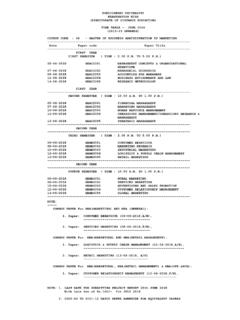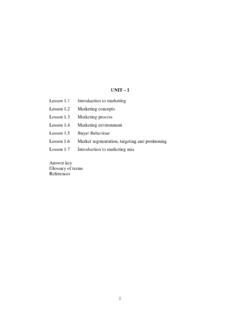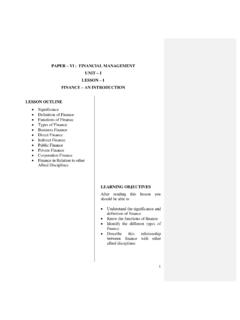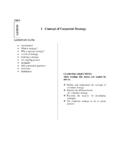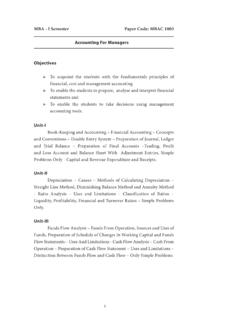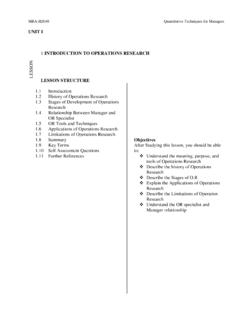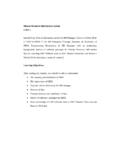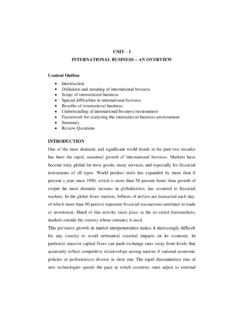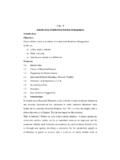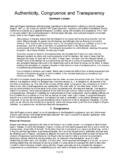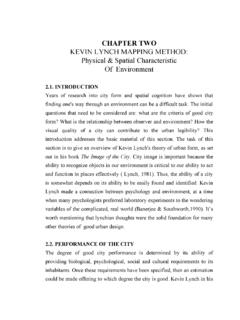Transcription of UNIT I PERFORMANCE MANAGEMENT THE …
1 UNIT I PERFORMANCE MANAGEMENT THE concept PERFORMANCE is understood as achievement of the organization in relation with its set goals. It includes outcomes achieved, or accomplished through contribution of individuals or teams to the organization s strategic goals. The term PERFORMANCE encompasses economic as well as behavioural outcomes. Brumbach views PERFORMANCE more comprehensively by encompassing both behaviors and results. He is of the view that behaviors as outcomes in their own right , which can be judged apart from results . PERFORMANCE is an impact. The roles of any manage can be seen in three parts: Being, Doing and Relating. Being it is concerned with the competencies of the manage that are relevant to his/her PERFORMANCE .
2 It is preparedness of the mind of the manager. Doing focuses on the manage activities that are variably effective at different levels in the organization: that affect PERFORMANCE of other roles dependent on the manage output, and the organizational PERFORMANCE as a whole. As someone said, Ideas are funny little things. They won t work unless you do. Relating emphasizes the nature of relationships with members of the role network-vertical, horizontal or otherwise. PERFORMANCE has a linkage with the individual potential and how best it is realized by the individual. With regard to manage, his/her potential becomes the input to the productive process and PERFORMANCE is the output. Managee s Potential is determined when a set of tasks are assigned to him.
3 It is also related to PERFORMANCE standards set. Task-related activities refer to managee s or supervisors involvement to achieve the allocated task or meet expectations in the given task environment. PERFORMANCE is what the managee s actually achieve. PERFORMANCE in a role refers to the extent to which the managees achieve the purpose for which the role is created. Choice, not chance , they say, determines destiny . The actual PERFORMANCE of a managee is a function of several forces, internals as well as external to the organization-some of choice, some of chance. Most organizations do not take these forces into account-either systematically or intuitively-while building expectations from a managee.
4 A managee in her task environment could be subject to some of the influences and factors shown in Exhibit. Framework to Understand Role PERFORMANCE In this framework, Organizational Relevant Environment, Role Purpose or Objective, Stakeholder Expectations, Role Technology and Input Role or Vendor Contribution are inputs to the managee s PERFORMANCE . These are substantially known, and are the factors and forces, which organizational expectations from the Managee PERFORMANCE can reasonably be predicted. Role Design, Managee Potential, Managerial Leadership, Competing and Collaborating Colleagues, and Group Climate are throughput factors that can be optimized by a manager to enhance the Managee PERFORMANCE . These determine whether the organization s PERFORMANCE expectations from a managee are realistic.
5 As such, throughput factors are the core concerns of PfM. It can be argued that Role Design and Managee Potential are, in fact, input factors. However, a manager can modify-enhance or stretch-these factors by improving the fit between the managee s capacities, resources and role requirements, PfM would assume these as throughput factors. Role Output or Managee PERFORMANCE is the end-result-the effect for which we work. This is the variable that is predicted or planned. It is invariably observable and measurable. The behavior of all organisms is goal-directed. As such, people PERFORMANCE is not only a sequence of causes and effects; it is a chain of sub-goals and actions, leading towards the ultimate goal.
6 In fact, when a managee has a goal, he/she behaves as if she is following some signposts that create a healthy expectancy in him/her to reach the goal. Role Purpose or Objective sets the boundary for the goal(s). It is a reference point for Stockholder s Expectation. Managee Potential corresponds to the role to which a managee is assigned and the inputs he/she receives to fulfill the role purpose. It stretches or contracts depending upon the Group Climate, the behavior of the Competing and Collaborating Colleagues, and the Managerial Leadership. The actual realization of a managee s potential depends heavily on: Group and Organizational Purpose. Group or Organization Capacities and Resources.
7 Human Climate in the Group or the Organization. Quality of Up-stream or Vendor Inputs. Feedback on PERFORMANCE . Role Design is fashioned by the organizing process. The sole purpose of organizing and designing a role is to provide a vehicle for implementing PERFORMANCE plans and expectations. It determines the requisite competencies, knowledge and skills. Role design predominantly determines task-related attributes needed by the managee. Managerial Leadership predominantly determines the behavioral attributes needed by the managee. Leadership role of the manager and managerial style of the leader are also major determinants of the managee s development and his/her job satisfaction. Managerial leadership and group climate have considerable influence on each other.
8 Group Climate - The internal psychological environment of the group-influences the behavior, style and PERFORMANCE of the managee. It is also, in turn influenced by the behavior and attitude of the managee. Group climate is after all, the collective outcome of the behavior and attitudes of all the members of the group-the managee and all his/her competing and collaborating colleagues, the manager or the leader. People in any group or organization are less anxious about work if both goal clarity and goal agreement are present. Considerable conflict arises when purposes are unclear or when people disagree on what the priorities should be. Without convergence on goals and priorities, groups or organizations cannot develop a climate that facilitates PERFORMANCE .
9 Three abilities or forces in an individual are said to be essential for achievement: Icchha-desire or motivation; Jnana-knowledge or know-how: and Kriya-action to actualize. Not much PERFORMANCE achievement has been reported without the creative combination of these three forces which, acting dynamically and in concert, form the core motive force of all people in any organization. Through the medium of PERFORMANCE , an organization is able to effectively achieve what it sets out to. Indeed, it is the people s capacities and resources that determine an organization s capability to perform and to satisfy or influence its stakeholders. These capacities and resources reflect a measure of the internal state of an organization that is expressed through its results.
10 PERFORMANCE MANAGEMENT is a way of systematically managing people for innovation, goal focus, productivity and satisfaction. It is a goal congruent win- win strategy. Its main objective is to ensure success to all managees , all task teams who believe in its process, its approach and implementation with sincerity and commitment. The managee s success is reflected in organisations bottom line in terms of achieving its planned goals. PfM is an endless spiral, which links several processes such as PERFORMANCE planning, managing PERFORMANCE throughout the year, taking stock of managee s PERFORMANCE and potential. Also it includes recognizing and rewarding success at the end of the year. PfM links these processes in such a way that an individual managees PERFORMANCE is always oriented towards achieving organisational goals.
